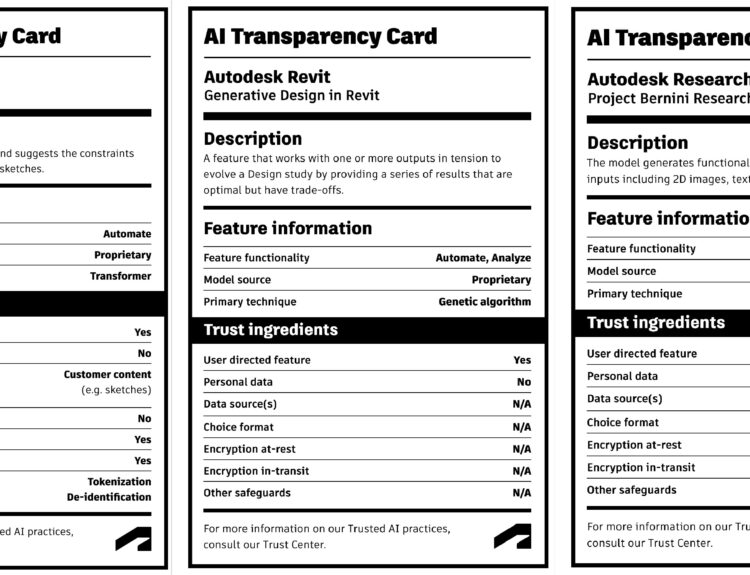Yesterday, I attended the 2019 Industrialized Construction Forum held by Stanford University Center for Integrated Facility Engineering. This was a packed event attended by by not only academia, but also included industry and technology providers. The presentations, panel discussions, and conversations with attendees were very good and thought provoking on the impact and changes to construction and our built world in the near term and long term future. Some of the technologies and considerations involved society, AI/ML, robotics, offside prefab, modular construction, skyrocketing costs from labor and materials, and all considered sustainability both a goal and benefit.
My big takeaway is that Industrialized Construction “IC” may be the best solution to solving the limited resources, reducing carbon footprint, addressing the global housing shortage, and overcoming the labor shortage in the construction industry.
We at Autodesk couldn’t agree more in doing More, Better, with Less.
Autodesk’s Dace Campbell (DaceCampbell) had some great notes on the forum.
“1. IC, prefab, modular construction, etc has been around for decades, but the demand has never been more acute, given forecasts for global population growth, climate change, and shrinking construction workforce.
2. Lip-service was paid to BIM, IPD, and Lean to set context for IC, but very few presenters made a meaningful connection to these complementary concepts, processes, and trends.
3. Most showcased residential use cases: multi-family, custom single-family, emergency shelters, etc. But where are the countless applications and success stories in commercial, healthcare, and education?
4. There was a bias towards smaller, industry-disrupting processes and companies to the detriment of meaningful discourse about: A. General Contractor's deep concern for, and ability to manage, risk. B. MEP trade partners' depth of experience with interdisciplinary prefab.
5. Interesting points made about the balance between production efficiency and a client-facing service. But, surprisingly little nod to incorporating architects as design *partners*.
6. Surprisingly little discussion about proven business cases, new business models, and creative entrepreneurship opportunities necessary to execute IC globally, at scale.”
If you want to learn more in depth research on Industrialized Construction in the US and some research data, a detailed white paper was released at the event.
A Preliminary Overview of Emerging Trends for Industrialized Construction in the United States
https://www.indconstructionforum.com/resources.htmlTyler Pullen
Teaching Staff, Stanford University Engineering Consultant, City Systems
Daniel Hall
Assistant Professor, ETH Zurich
Jerker Lessing
Director of Research, BoKlok Adjunct Professor, Stanford University”Executive Summary
This paper seeks to capture and analyze the recent growth in industrialized construction in North America from new and existing companies. The concepts and technologies of industrialized construction (IC) – such as prefabrication, preassembly, modular, offsite, and volumetric construction – are relatively well-established. However, the sudden attraction of large-scale investments for entrepreneurial firms adopting these strategies is unprecedented in the AEC sector. The causes of this interest are varied and outside of the scope of this paper. Instead, , this paper provides an overview for the current status and potential future of practitioners in this space. To do so, we compare the orientations of industrialized construction firms in the United States across a broad spectrum of categories comprising target markets, business models, and basic strategic details. This white paper reports on high level trends for industrialized construction spreading across the AEC sector in the United States. Specifically, we find nine distinct trends evident in the data across the last two decades:1. IC companies are growing in number
2. IC is attracting investor funding
3. IC companies emerge from different origins
4. California is leading the United States market
5. The majority of the companies are building volumetric modular
6. Structural system type correlates with building height; mid- and low-rise leads the market
7. IC companies are vertically and horizontally integrated
8. Most IC companies are targeting housing 9. The affordable housing market is active despite a lack of investmentOverall, we find that industrialized construction companies are generating the investment, strategic variety, capacity, and ambition to be worthy of serious attention across the AEC sector. The white paper concludes with future opportunities and strategies yet to be taken that may be important in achieving meaningful differentiation. These include the role of city governments, investment in operations and maintenance, the use of factory automation, and possibilities for more business integration. As old and new firms expand, business models mature, and effective technologies are implemented, more in-depth research can build upon this white paper to yield additional insights and trends for industrialized construction in the United States.”
2019 Industrialized Construction Forum Agenda:
9:00 Welcome and Introduction
- Martin Fischer, Professor and Director of CIFE – Center for Integrated Facility Engineering
- Daniel Hall, Professor at ETH Zurich
9:20 Global Activity in IC, presentations and discussion
- Mark Farmer, CEO of Cast in UK
- Wei Pan, Professor at University of Hong Kong
I liked his historical highlight that offsite prefab has been occurring for 6500 years with pyramids and the great wall. Very interesting to hear the scale of construction needed in Hong Kong. - Jerker Lessing, Adjunct Professor at Stanford and R&D Manager at BoKlok in Sweden
10:35 Panel Discussion: Lessons from the Global Movement
11:25 Technology Advancements in Switzerland, presentations and Q&A
- Daniel Hall, Assistant Professor, Innovative and Industrial Construction, ETH Zurich
- Konrad Graser, Project Manager at DFAB HOUSE
11:55 Q&A – Industrialized Construction, Robots, and More
Greg Howes & Stefan Schneider of CutMyTimber.com showing their SideYard mass timber construction in Portland
1:15 IC in Developing Economies, presentations and discussion
- Bushra Bataineh, CEO and Founder of Mawa Modular, with colleague Ruth McGee
- Alexandria Lafci, Co-Founder of New Story I was blown away by Alexandria's presentation.
- Francesco Piazzesi, Founder and CEO of Echale a tu Casa in Mexico
2:05 Panel Discussion: Lessons from Developing Economies
3:00 IC Activity in the US, presentations and discussion
- Rick Holiday, CEO of Factory OS in California
- Steve Glenn, CEO and Founder of Plant Prefab
- Jen Hawkins & Eric Luttmann from Digital Building Components in Arizona
- Forest Flager, Katerra
4:00 Panel Discussion: IC Applications in the US
This was a great event and I met many new industry connections and leaders. It was also very nice to see the stunningly beautiful Stanford University campus.
Best,
-Shaan



